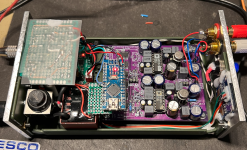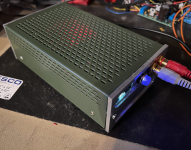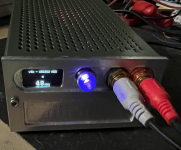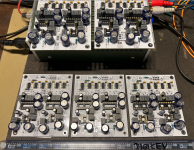2vrms = 5.6vppSay, ad1862 outputs +/-1mA, through Riv of 100ohm, we've got 0.2Vpp, to get your 2Vrms which is 2.8Vpp, you need 2.8/0.2= gain of 14. Take a value of 17 min.
Perfect for a 6dj8 and friends, less for 300b or 2p29l... But perhaps 2p29l can do it with a small helper as a source follower...
Hence need a gain of 28 if using 100 ohm for Riv
References:
- #5186 Thermionic Valve Analogue Stages for Digital Audio (from Miro's Blogdpot) (the ad1862 is talked as well)
But specific following stage you of course doesn't always need 2V RMS (as you already know). Even more if you have a buffer or an hybrid Mu follower after the I/V.
ECC88 with 30/33 Mu is enough if you have gain after (pre), of course 12AX7 even better (?) Mu wise.... 5687 buffered 🙂 ?!
You are of course forgiven if the broccoli was with peccorino, tomate and "creme fraiche" !
What I like is the fact that the CFA/WJ AD811 PS combo may sounds better than some tubes and again whatever Coleman reg, diodes bias, etc not sure a DHT is a good idea for 1 mA (if not in a leas sarcophage coffin... but you loose the gloss ligth ! ) I would cope to IHT if already having a DHT pre, or simply go discrete or op amp in soic for smt parts around because technical reasons and work on the PS and caps to setup the tons finer.
Just me of course, but does it make sense to have a resistor passive I/V with gain after and not a flat impedance input and limited bandwidth for a digital ic current output based ? Better to have vynil then(imho) than ruling a dac ic that way... And nothing stoip you to go sand for I/V and tube for buffer in spite of an hybrid Mu follower or 100% tubes.
Sometimes we just buy a magic formula that is not the rigth sentence for the problem to solve... here DHT to spell on AD1862 1mA output !
my 2 cents, anyway that diy, try them all if time and monney enough 🙂, proof is in the pudding after all and the beauty in the mouth of the (h)eater !
- #5186 Thermionic Valve Analogue Stages for Digital Audio (from Miro's Blogdpot) (the ad1862 is talked as well)
But specific following stage you of course doesn't always need 2V RMS (as you already know). Even more if you have a buffer or an hybrid Mu follower after the I/V.
ECC88 with 30/33 Mu is enough if you have gain after (pre), of course 12AX7 even better (?) Mu wise.... 5687 buffered 🙂 ?!
You are of course forgiven if the broccoli was with peccorino, tomate and "creme fraiche" !
What I like is the fact that the CFA/WJ AD811 PS combo may sounds better than some tubes and again whatever Coleman reg, diodes bias, etc not sure a DHT is a good idea for 1 mA (if not in a leas sarcophage coffin... but you loose the gloss ligth ! ) I would cope to IHT if already having a DHT pre, or simply go discrete or op amp in soic for smt parts around because technical reasons and work on the PS and caps to setup the tons finer.
Just me of course, but does it make sense to have a resistor passive I/V with gain after and not a flat impedance input and limited bandwidth for a digital ic current output based ? Better to have vynil then(imho) than ruling a dac ic that way... And nothing stoip you to go sand for I/V and tube for buffer in spite of an hybrid Mu follower or 100% tubes.
Sometimes we just buy a magic formula that is not the rigth sentence for the problem to solve... here DHT to spell on AD1862 1mA output !
my 2 cents, anyway that diy, try them all if time and monney enough 🙂, proof is in the pudding after all and the beauty in the mouth of the (h)eater !
Last edited:
I've ordered the CPLD/USB Blaster to try with one of the boards I have. Great being able to "program" it without using code 🙂
I've got one PCM1702 and two PCM63 boards. One of the PCM63 boards is the one with the I2SoverUSB footprint. I'm thinking the last one of the above would be good for trying out the CPLD.
I've got one PCM1702 and two PCM63 boards. One of the PCM63 boards is the one with the I2SoverUSB footprint. I'm thinking the last one of the above would be good for trying out the CPLD.
And you could try an ecc88 or a D3A with plate choke loaded, simply. 😉.
Grunf here prefered at the end CFA over tubes....
Grunf here prefered at the end CFA over tubes....
Here’s my first attempt at this DAC.
I wanted something simple, with an SPDIF input, as a daily driver for PC.
It features LME49710HA amplifiers (old samples), DIR9001, a 2x15V 3VA transformer, LM317/337, and 78/79L05.
Case is from old military NiCd charger, front, and back made by me on my small CNC.
The goal was simplicity and the smallest possible enclosure, as a bonus, I added a frequency indicator.



A few other versions are in progress.

By the way, thank you to the creator for a great project.
I wanted something simple, with an SPDIF input, as a daily driver for PC.
It features LME49710HA amplifiers (old samples), DIR9001, a 2x15V 3VA transformer, LM317/337, and 78/79L05.
Case is from old military NiCd charger, front, and back made by me on my small CNC.
The goal was simplicity and the smallest possible enclosure, as a bonus, I added a frequency indicator.



A few other versions are in progress.

By the way, thank you to the creator for a great project.
Hi, looks fine🙂
Did you have tried both lm317 and 78xx and notice à difference ?
Did you have tried both lm317 and 78xx and notice à difference ?
Last edited:
ECC88 with 30/33 Mu is enough if you have gain after (pre), of course 12AX7 even better (?) Mu wise.... 5687 buffered 🙂 ?!
Valves are a personal choice, of course. For a gain of 30 the ECC88/6922 or 6N1P are OK. Also ECC40 on a rimlock base, mu=32. E180CC at mu=48 if you want more gain. A better sounding valve at mu=27 is the E80CC especially the silver pin Tungsram ones. For a mu of 20 we have the 6SN7 which can be very good sounding. 5687 can be nice but mu=18 and there's the 6N30 at mu=15. I'd never use a 12AX7 except in a phono stage or a guitar amp.
Last edited:
ask him he shared a lot here. I dunno remember but he made a cool listening review benchmark.
@andyjevans : 5687 GE : for the buff, not the I/V. Mu of >30 for I/V.... it's 1 mA for AD1862 (don't remember for AD1865) : but someone made an interresting input here : according the dac ic the tones are not the sames (to phrase it short) : so some tubes marry better than other for the buff. There is as you know a long story with AD1865 and tubes, silver virgins coils, etc : don't be too much influenced by it.
The tubes that work are well known with their drawback too (too much Mu is more difficult to get rigth etc,)
Will you use OT or DC caps, Mu follower or pure choke with the plate or 100% fet CCS ?
Go your way,but don't forget to tries the known good woorking solutions too.
To dig a little in what I said : there is two interresting inputs about tubes and sand : Michelag finally prefers CFA over a (not so good chineese tube iirc for the task) tube. And the guy that digged up the old Walter Jung AD811 shematic said so but is very experienced with tubes (but a little too much Ei tubes which have their "own sound" one may like or not). Michelag tried both of his conf. I don't know or remember if Woddturnerfran has tried CFA from the AD811 that is here (Vunce) and elswhere by Grunf. I didn't too, for me it is partially flawed by design (One of the most important goal is to have the less input Z in order a current DAC works rigth, the CFA needs a serie Z to not oscillate att the input... but 1000R is also still a lot less than all theop amps here...but the op861 used Pedja Rogic way as far I know. (but needs tonal fixing care with the passive parts around, then it is the paradise... at least for I. I try to work of a new concept of T Loesch with TDA1541A and a PCB of mine but that is another story... not so easy, devil are in the details and they are legion... but T is very nice and helpfull... and guess what ? Despite he is the AMR CD77 designer he wants go for discrete BJT with that chip now... devil in the details.)
So what will extract the most exact information from your current output stage is what is worthing. You can fix tones later : from the buff to the amp.
At least, my 2 cents and friendly input (remember I don't play jazz but listening a lot of it too and I am not the less exigent)
The tubes that work are well known with their drawback too (too much Mu is more difficult to get rigth etc,)
Will you use OT or DC caps, Mu follower or pure choke with the plate or 100% fet CCS ?
Go your way,but don't forget to tries the known good woorking solutions too.
To dig a little in what I said : there is two interresting inputs about tubes and sand : Michelag finally prefers CFA over a (not so good chineese tube iirc for the task) tube. And the guy that digged up the old Walter Jung AD811 shematic said so but is very experienced with tubes (but a little too much Ei tubes which have their "own sound" one may like or not). Michelag tried both of his conf. I don't know or remember if Woddturnerfran has tried CFA from the AD811 that is here (Vunce) and elswhere by Grunf. I didn't too, for me it is partially flawed by design (One of the most important goal is to have the less input Z in order a current DAC works rigth, the CFA needs a serie Z to not oscillate att the input... but 1000R is also still a lot less than all theop amps here...but the op861 used Pedja Rogic way as far I know. (but needs tonal fixing care with the passive parts around, then it is the paradise... at least for I. I try to work of a new concept of T Loesch with TDA1541A and a PCB of mine but that is another story... not so easy, devil are in the details and they are legion... but T is very nice and helpfull... and guess what ? Despite he is the AMR CD77 designer he wants go for discrete BJT with that chip now... devil in the details.)
So what will extract the most exact information from your current output stage is what is worthing. You can fix tones later : from the buff to the amp.
At least, my 2 cents and friendly input (remember I don't play jazz but listening a lot of it too and I am not the less exigent)
Last edited:
But the PCB will not be avialable but for the few friend I have here as I have not rigth to publish anymore in the TDA1541A long thread cause a troll againt I react, certainly the fault of a mod that trigerred because think "fantastic positive wording thinking magic childrenhood way" but don't read well the causes).
Hope someone else than I, will translate it, as I was trying to do with his help by PM what the TDA1541A deserves ! For now you have miro's tries with TDA1541A.
So here don't help people and react to the trolls that never help, it is the social death ! You eventually weigth the same for mods.
Farenheit 451 here, it is okay if you are condesscending against a member and promise you are a saint to the others, but never react strongly : appearance are weigthing more than the real behavior !
Farenheit 451 place here, definitly !
Sorry for the personal input. But being slaughtered in silent is not in my personality ! Well I hope I made at least usefull inputs in thet thread.
Hope someone else than I, will translate it, as I was trying to do with his help by PM what the TDA1541A deserves ! For now you have miro's tries with TDA1541A.
So here don't help people and react to the trolls that never help, it is the social death ! You eventually weigth the same for mods.
Farenheit 451 here, it is okay if you are condesscending against a member and promise you are a saint to the others, but never react strongly : appearance are weigthing more than the real behavior !
Farenheit 451 place here, definitly !
Sorry for the personal input. But being slaughtered in silent is not in my personality ! Well I hope I made at least usefull inputs in thet thread.
Last edited:
I don't restrict myself to "well known" tubes - I use what sounds best to my ears and I've been testing over 100 different types in the last 15 years. Yes, for the AD1862 the choices would be the conventional 6922/6N1P or E180CC. For me I'd add the rimlok ECC40. But the E80CC is seriously better sounding, like I say the Tungsram silver pin ones in preference. That's a hot tip.@andyjevans : 5687 GE : for the buff, not the I/V. Mu of >30 for I/V.... it's 1 mA for AD1862 (don't remember for AD1865) The tubes that work are well known. Will you use OT or DC caps, Mu follower or pure choke with the plate or 100% fet CCS?
For me with a AD1865 and 200 ohm RIV I can use better tubes with gain of 12 upwards, starting with DHTs. I will use what to my ears sounds best - a resistor load of 5x the Ri of the tube. Teflon output cap of 0.1uF because this will feed a valve stage. No need for any stepdown since the input resistor will be 100K. That way you can use all the best sounding parts.
continue the good job 🙂. Just shared my opinion, tried to save you time or monney, at least related to my experience. And some have tried 200 tubes (not me, but they advise here and elswhere often too, and at least you know Ale).
To me Teflon cap are bad to my ears. (and here I think I tested almost it all... my mojo is caps more than tubes)
To me Teflon cap are bad to my ears. (and here I think I tested almost it all... my mojo is caps more than tubes)
Last edited:
The 6922 is definitly not a so good tube for audio and even less for I/V (it becomes too much microphonic fastly when agging, ECC88 is at the opposit good for obvious reasons ! The best next choice if you can find one is the E188CC.
Again, work the I/V as it was a phono stage to write it short for technical reason, and use a buf for technical reasons too for helping the input impedance of the I/V. You can use more easilier at Buffer stage the good 200 tubes experience that is own taste and personal setup related. Or you simply risk to loose what is the advantage of a good output curerent DAC ic.
Of course, just next to your fav DHT, story to have a benchmark. I am not saying you shouldn't try it if you want. Just that technicals reasons dictates better choice for tube (hence IHT)
My 2 cents, look forward to read your listening experience after the construct as Woodturnerfran did.
best regards
Again, work the I/V as it was a phono stage to write it short for technical reason, and use a buf for technical reasons too for helping the input impedance of the I/V. You can use more easilier at Buffer stage the good 200 tubes experience that is own taste and personal setup related. Or you simply risk to loose what is the advantage of a good output curerent DAC ic.
Of course, just next to your fav DHT, story to have a benchmark. I am not saying you shouldn't try it if you want. Just that technicals reasons dictates better choice for tube (hence IHT)
My 2 cents, look forward to read your listening experience after the construct as Woodturnerfran did.
best regards
Thx.Hi, looks fine🙂
Did you have tried both lm317 and 78xx and notice à difference ?
Not really. I think it would be possible to measure this, but during listening, in my opinion, there’s no noticeable difference, the power amplifier introduces more noise.
The LM317s are configured to reduce ripple, with a 10uF capacitor connected to the ADJ pin.
I also have a power supply with 7812 and 7912 regulators, but the issue is that small transformers like these have very high voltage when running without a load.
It was approaching the voltage limit for the 78/79 series, so I decided that the LM3xx regulators would be safer for this application.
Normally, the voltage shouldn’t rise to such levels because the power supply is loaded by the circuit, but I figured it was better to have a reasonable margin.
I had planned space for a heatsink, but it turned out that the back of the enclosure handles the heat perfectly.
but I want to congrat @V4M for his nice build, asking him for more detail about his arduino code for frequency display 😉
and what are for all the populated boards without jewels of the crown ? 😀
I used code linked in the authors blog page from first page of this thread, and modify it for my application.
I had also tried to add a bit display, and move it to RP2040, but it use to much power just for a display, so I keep it on nano v3.
Maybe in the future I will try to upgrade it, using RP2040 as it is far more powerful uC.
I decided that this DAC is so good that I’ll make it my default DAC for everything.
For work, for the headphone amplifier, and for the TV.
I have a whole box of soldered DACs with other converters, and there’s still the TDA1541 left, which I might assemble next year.
But for general use I choose AD1862.
I built a preamp with a Tesla 6CC42 dual triode (equivalent of 5670, 6N3P), and it sounds very good to me. The sound is a bit on the brighter side, it will suit the AD1865 better than the AD1862. Mu is probably about 36, something like that. One advantage of these tubes is the low height (half of the E88CC).
@miro1360 ,
Hi there, Do you knoow please an USB to JTK blaster wich is multiplatform/brand compatible, please ? (Altera, Xilink, etc) ?
Thanks, I'm making a TDA board with a QFN cpld and a non stop clock sim moide created by raptofigthing guy elswhere, but this JTK flashing thinhs are new to me.
Hi there, Do you knoow please an USB to JTK blaster wich is multiplatform/brand compatible, please ? (Altera, Xilink, etc) ?
Thanks, I'm making a TDA board with a QFN cpld and a non stop clock sim moide created by raptofigthing guy elswhere, but this JTK flashing thinhs are new to me.
- Home
- Source & Line
- Digital Line Level
- DAC AD1862: Almost THT, I2S input, NOS, R-2R